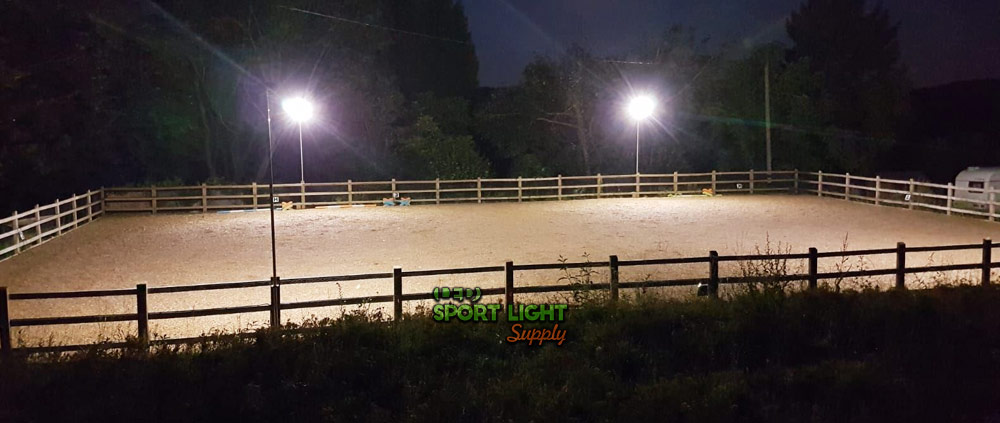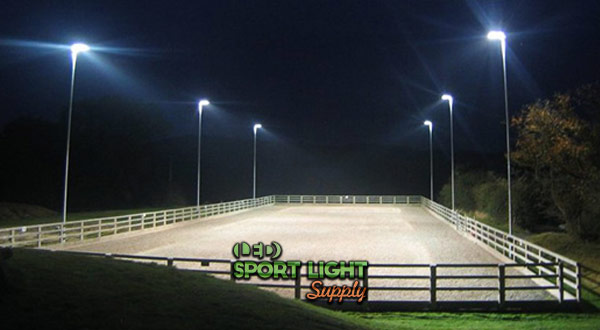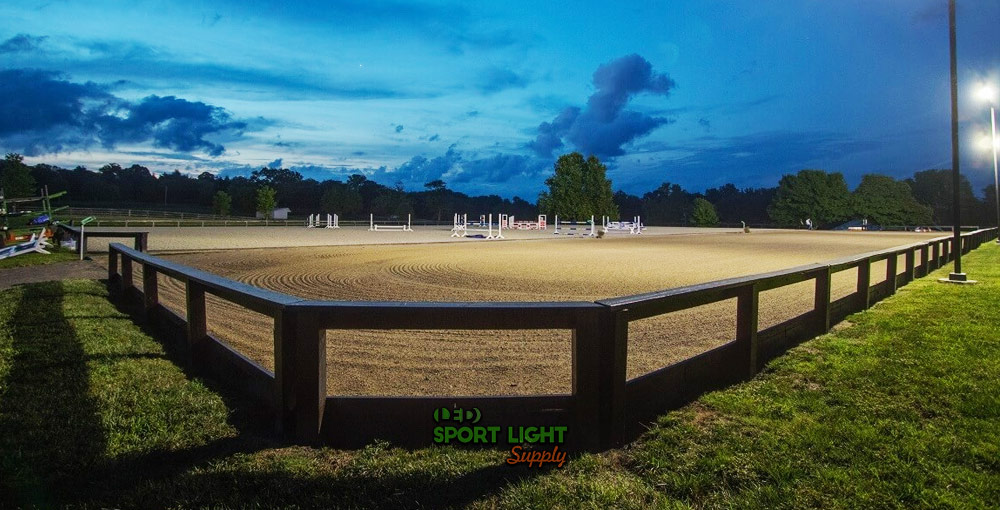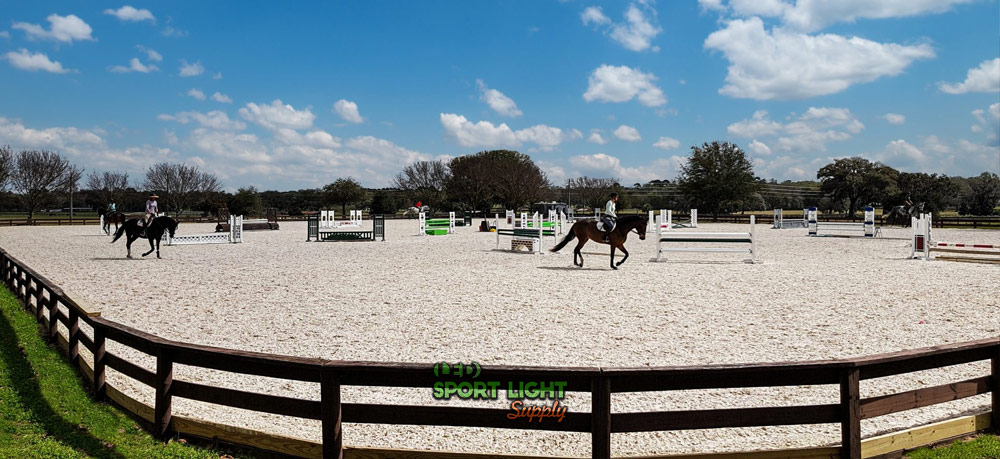Solar riding arena lights offer an effective lighting solution for various outdoor arenas. For instance, these lights can be installed in a roping arena to help cool down your horse after an intense training session. They are also ideal for a dressage arena, providing illumination for evening equestrian events.
Solar lighting systems utilize photovoltaic panels to convert sunlight into electrical energy. This energy is stored in a battery, allowing for later use. While these systems primarily support lighting devices, they can also deliver sufficient brightness for safe equine activity during late afternoons.
For horse owners who are new to solar lighting, here are some essential facts to help you understand its benefits and applications.
Table of Contents
ToggleAdvantages of LED Solar Horse Arena Lights

Hassle-Free Installation
Solar riding arena lights offer a straightforward installation process, especially beneficial in settings where mobility is essential. Traditional lighting systems often involve complex wiring, which can be cumbersome and potentially hazardous for horses. In contrast, solar lights only require a photovoltaic panel and a battery, eliminating the need for underground cables or overhead wires. Most models come with clamps or brackets, allowing for flexible installation options. This ease of setup saves both time and money, making it an attractive choice for many equestrian facilities.

No Electricity Costs
One of the major benefits of solar horse arena lights is the absence of electricity costs. By converting sunlight into electrical energy, these lights reduce the expense of powering your arena. The key is to place the solar panels in a location where they receive optimal sunlight. While some models can be plugged into the national grid or connected to an additional generator for backup, they continue to function even during power outages. The built-in battery ensures that your arena remains illuminated without incurring additional costs.
Reduced Maintenance Costs
Switching to solar horse arena lights can dramatically lower maintenance expenses. These fixtures are known for their durability and long lifespan, often exceeding 150,000 hours of use. Unlike traditional metal halide or high-pressure sodium lamps, solar lights do not overheat and are highly reliable. Regular maintenance involves cleaning the photovoltaic panel to remove dust, which is a simple task that only needs to be performed once or twice a year. This minimal upkeep is a significant advantage over older lighting systems that require frequent replacements and repairs.

Smart Control Features
Solar lighting systems come equipped with various smart control options to enhance usability and safety. These include sensors for dusk-to-dawn operation, motion detection, wireless control via dedicated apps, and Bluetooth remote control. Such features allow for precise control over lighting conditions, which can be particularly useful for specific equine activities or competitions. For instance, motion sensors can also function as security lights, providing additional safety for both riders and horses.
Enhanced Safety
The safety of solar lights is another notable advantage. They operate on a low DC voltage (12V), reducing the risk of electric shock, which is beneficial for both equestrians and their horses. The design of solar lights typically includes an enclosed casing with minimal exposed components, further enhancing safety. Unlike traditional floodlights with potentially dangerous cables, solar lights are less likely to cause tripping hazards or other issues.
Independent Operation
Each solar light operates independently, which means that if one light fails, it will not affect the performance of others. This feature is particularly useful for emergency lighting or as support during power outages. For example, placing solar lights near the entrance of a horse barn can provide soft, independent illumination to guide horses safely. The absence of interconnected systems minimizes the risk of disruption, ensuring continuous and reliable lighting.
Disadvantages of LED Solar Horse Arena Lights
Lower Brightness
Solar lighting systems generally offer lower brightness compared to high-powered LED floodlights, which can exceed 500 watts. Typical solar LED floodlights have a wattage range of around 50 to 200 watts. While some solar lights are adequate for residential or recreational horse arenas, they may not match the intensity of more powerful systems.
To maximize the effectiveness of solar lighting, a well-thought-out lighting design is essential. Strategic placement of solar lights can help achieve adequate illumination while keeping operating costs low. An expert’s approach ensures that solar lights are positioned to provide optimal brightness and avoid glare. Proper placement of the photovoltaic panel is crucial for capturing sufficient daylight while maintaining effective lighting levels.
Dependence on Sunshine

Solar lights rely on sunlight to function and charge the battery. Consequently, they are not suitable for shaded areas or locations obstructed by trees or buildings. While daylight provides around 100,000 lux, which is ample for fast charging, an overcast day may only deliver 1,000 to 2,000 lux, slowing down the charging process. Solar lights do not charge at night, which can limit their effectiveness during periods of low sunlight.
Despite these limitations, solar lights can be beneficial for certain activities. For instance, they are effective in a roping arena where specific lighting needs can be managed according to the activity. Additionally, they are useful for tasks like rugging a horse during winter or cleaning hooves, which require minimal light and do not significantly drain the battery.
Need for Regular Cleaning
Solar panels require regular cleaning to maintain efficiency. Dust and debris can accumulate on the photovoltaic panel, particularly after dusty rain or in windy areas where sand may settle. Residues may persist even after heavy rainfall, and occasional phenomena like blood rain can further impact the panel’s performance.
For arenas that host numerous exhibitions and competitions, such as a dressage arena, more frequent cleaning may be necessary to ensure optimal performance of the solar lights. Regular maintenance helps prevent reduced efficiency and ensures that the lighting system remains effective over time.
Can You Use Solar Flood Lights in a Horse Arena?
The suitability of solar flood lights for a horse arena largely depends on your specific needs and use case:
Yes, You Can
Solar flood lights are a viable option if you aim to save on installation time and costs associated with traditional lighting systems. They are particularly useful for temporary lighting needs or for recreational use. For homeowners and those managing a non-professional arena, solar flood lights can provide an efficient and cost-effective solution. However, they are generally better suited for less demanding applications rather than for high-level professional competitions such as those at the Grand Prix level.
No, You Should Not
If your requirement is for bright, permanent lighting throughout the year, solar flood lights may not be the best choice. They are not designed to offer continuous, high-intensity illumination needed for professional arenas. For consistent and reliable lighting, especially in a setting requiring high brightness like a soccer field or a large-scale equestrian competition, conventional high mast pole lights are more appropriate. These systems provide the necessary brightness and durability for extensive and ongoing use.
Solar Lighting FAQ
Can We Use Solar Lights for the Indoor Riding Arena?
Yes, solar lights can be used in an indoor riding arena, but it requires careful planning. To maximize sunlight exposure, the solar panels need to be installed on the roof or in an area where they can receive ample sunlight. This setup often requires professional installation to properly wire the fixtures and connect them to the photovoltaic panels.
For stable use, a precise lighting layout is necessary to determine the required wattage and ensure effective illumination. Calculating the appropriate solar panel output and making adjustments may be needed, but experienced professionals can handle these tasks efficiently.
How Long Does the Solar Battery Last?
The duration a solar battery can power the lights typically ranges from 3 to 8 hours, depending on the wattage of the solar lights and the battery’s capacity. Additional factors such as dusk-to-dawn photocells or motion sensors may also impact energy consumption.
Smart control systems can help reduce power consumption during idle times. Generally, a standard lithium battery in solar lights lasts around 500 recharges, though high-quality batteries may offer longer lifespans. Investing in a good-quality battery can extend the operational life of your solar lighting system.
How Much Does It Cost to Buy Solar Horse Arena Lights?
The cost of solar riding arena lights varies, typically ranging from $0.80 to $2 per watt. Prices depend on the brand, luminous efficacy of the LED lights, and overall quality. Higher luminous efficacy models are generally more expensive.
Fortunately, there are many options available on the market, allowing you to experiment with different models. For a budget-friendly approach, you can start by installing a portable solar light in a roping arena to test its effectiveness. Ensure the solar panel is positioned in a well-exposed area for optimal performance. If your riding arena receives ample daylight, this will enhance the light’s efficiency.
High-tech models offer added convenience and features, making them more suitable for both equines and equestrians. For instance, you can use these advanced lights to create a well-lit path to a water tank or help your horse become accustomed to new fixtures, thereby enhancing the overall experience.
Conclusion
Solar lighting offers a range of benefits for horse arenas, including reduced installation costs, lower energy expenses, and minimal maintenance. While they are well-suited for temporary and recreational use, their effectiveness depends on sunlight availability and specific lighting needs. For consistent, high-intensity illumination required for professional settings, traditional lighting systems may be more appropriate. By carefully considering your arena’s requirements and the available options, you can effectively integrate solar lighting to enhance your equestrian environment.
